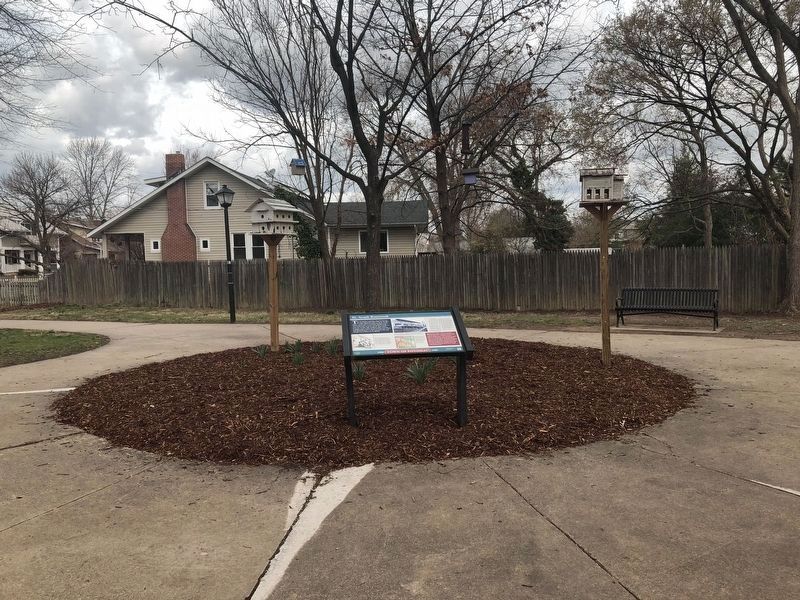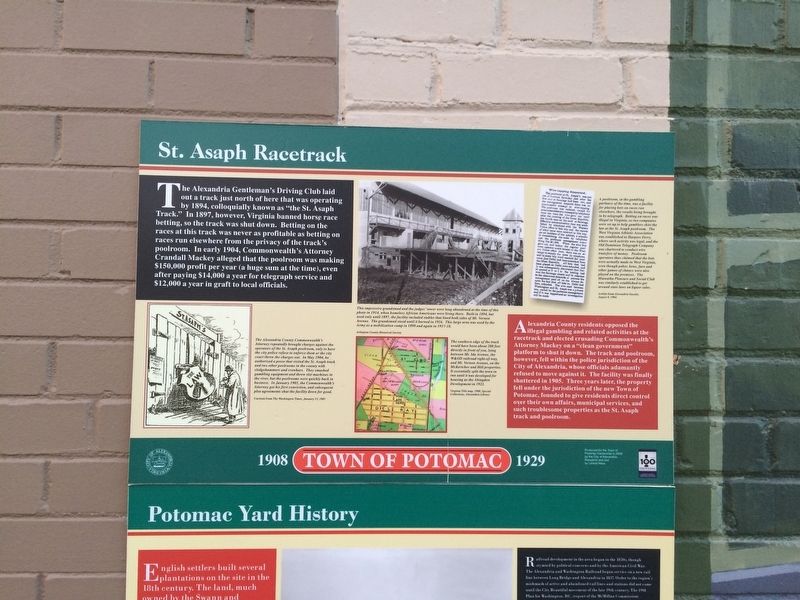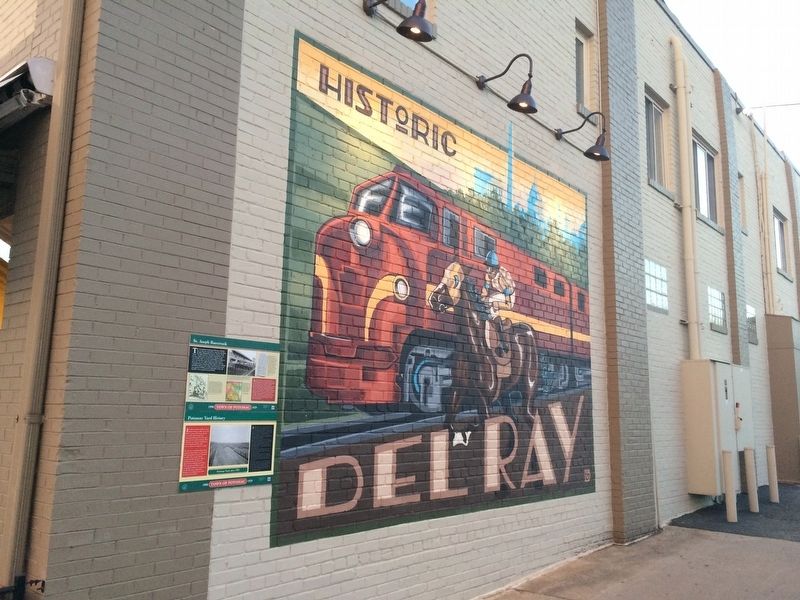Potomac West in Alexandria, Virginia — The American South (Mid-Atlantic)
St. Asaph Racetrack
Town of Potomac
— 1908 - 1929 —
The Alexandria Gentleman's Driving Club laid out a track just north of here that was operating by 1894, colloquially known as "the St. Asaph Track." In 1897, however, Virginia banned horse race betting, so the track was never as profitable as betting on races run elsewhere from the privacy of the track's poolroom. In early 1904, Commonwealth's Attorney Crandall Mackey alleged that the poolroom was making $150,000 profit per year (a huge sum at the time), even after paying $14,000 a year for telegraph service and $12,000 a year in graft to local officials.
Alexandria County residents opposed the illegal gambling and related activities at the racetrack and elected crusading Commonwealth's Attorney Mackey on a "clean government" platform to shut it down. The track and poolroom, however, fell within the police jurisdiction of the City of Alexandria, whose officials adamantly refused to move against it. The facility was finally shuttered in 1905. Three years later, the property fell under the jurisdiction of the new Town of Potomac, founded to give residents direct control over their own affairs, municipal services, and such troublesome properties as the St. Asaph track and poolroom.
[Captions:]
A poolroom, in the gambling parlance of the time, was a facility for placing bets on races run elsewhere, the results being brought in by telegraph. Betting on races was illegal in Virginia, so two companies were set up to help gamblers skirt the law at the St. Asaph poolroom. The West Virginia Athletic Association was established in Harpers Ferry, where such activity was legal, and the Old Dominion Telegraph Company was chartered to conduct wire transfers of money. Poolroom operators thus bets were actually made in West Virginia, even though poker, keno, fare and other games of chance were also played on the premises. The Hiawatha Pleasure and Social Club was similarly established to get around state laws on liquor sales.
Article from Alexandria Gazette, August 8, 1904.
Wire-tapping Suspected. The poolroom at St. Asaph's was put out of business Saturday just after the first race at Saratoga had been run, and the management suspects there was an unsuccessful attempt at wire-tapping. The poolroom was isolated, except for unsatisfactory messages by telephone from the time the wire gave out until after the running of the Great Republic, the fourth race on the card at Saratoga. Effective communication then was established by telephone with the Western Union office in this city and the reports of other races were received in this way. As an incident of the episode, a mistake in transmitting the news by telephonecost the poolroom management something like $1,000. When the wire first gave out, and before the regular poolroom operator could be sent in the Western Union office here, there was an attempt to supply the news by telephone, and in some way word reached the pool room that Delhi had been scratched from the Great Republic. All bets that had been placed on Delhi were refunded, and it was subsequently discovered that Delhi quoted at 8 to 1 in the betting had won the Saratoga classic and in response to the clamorous demands of patrons the management paid off on the winner despite the fact that all bets on Delhi had been refunded. The wire used between Washington and St. Asaph was a private one, owned by the poolroom management and if it was tapped and an investigation will be made
This impressive grandstand and the judges' tower were long abandoned at the time of this photo in 1914, when homeless African Americans were living there. built in 1894, but used only until 1897, the facility included stables that lined both sides of Mt. Vernon Avenue. The grandstand stood until it burned in 1916. This large area was used by the Army as a mobilization camp in 1898 and again in 1917-18.
The Alexandria County Commonwealth's Attorney repeatedly brought charges against the operators of the St. Asaph poolroom, only to have the city police refuse to enforce them

Photographed By Devry Becker Jones (CC0), March 30, 2018
3. A second, larger plaque is nearby in Charles W. Hill Park
The southern edge of the track would have been about 200 feet directly in front of you, lying between Mt. Ida Avenue, the W&OD railroad right-of-way, and Mt. Vernon Avenue, on the McKericher and Hill properties. It essentially split the town in two until it was developed for housing as the Abingdon Development in 1922.
Erected 2008 by City of Alexandria, Virginia.
Topics and series. This historical marker is listed in these topic lists: Animals • Communications • Government & Politics • Industry & Commerce. In addition, it is included in the Virginia, The City of Alexandria series list. A significant historical month for this entry is January 1905.
Location. 38° 49.636′ N, 77° 3.524′ W. Marker is in Alexandria, Virginia. It is in Potomac West. Marker is on Mount Vernon Avenue south of East Uhler Avenue, on the right when traveling north. Touch for map. Marker is at or near this postal address: 2525 Mount Vernon Avenue, Alexandria VA 22301, United States of America. Touch for directions.
Other nearby markers. At least 8 other markers are within walking distance of this marker. Potomac Yard History (here, next to this marker); Universal Lodge No. 1 (within shouting distance of this marker); The Town of Potomac / Mount Vernon Avenue (within shouting distance of this marker); Schools in the Town of Potomac (about 400 feet away, measured in a direct line); The Electric Railway (about 600 feet away); a different marker also named St. Asaph Racetrack (about 700 feet away); Corporal Charles William Hill (about 700 feet away); Captain Rocky Versace Plaza and Vietnam Veterans Memorial (about 700 feet away). Touch for a list and map of all markers in Alexandria.
Credits. This page was last revised on January 27, 2023. It was originally submitted on March 17, 2018, by Devry Becker Jones of Washington, District of Columbia. This page has been viewed 467 times since then and 47 times this year. Photos: 1, 2. submitted on March 17, 2018, by Devry Becker Jones of Washington, District of Columbia. 3. submitted on March 31, 2018, by Devry Becker Jones of Washington, District of Columbia. • Bernard Fisher was the editor who published this page.

